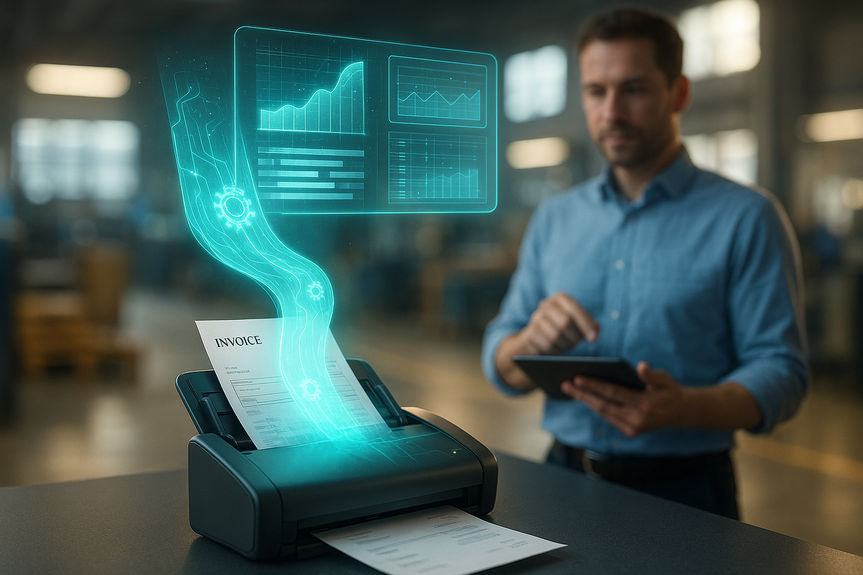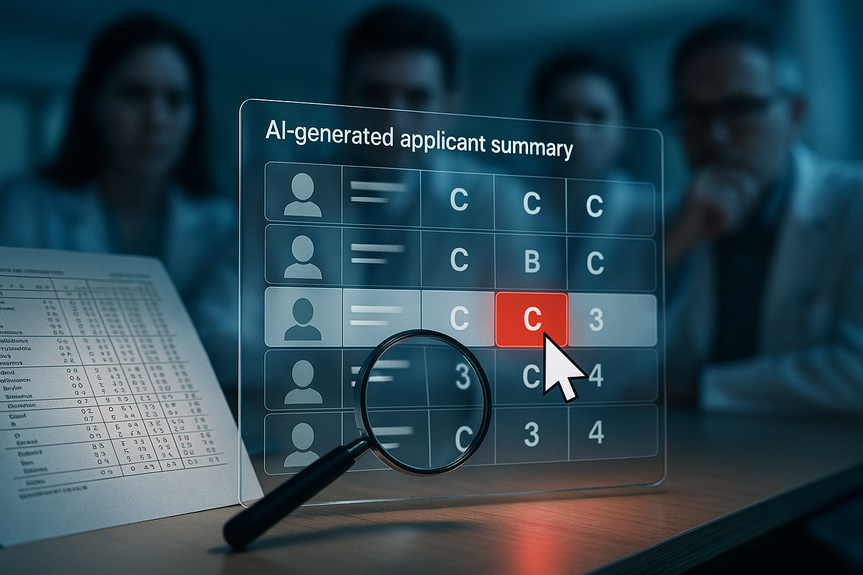AI invoice automation for manufacturers slashes processing time and eliminates manual data entry now.
AI invoice automation for manufacturers cuts manual data entry, shortens approval cycles, and reduces errors in accounts payable. By reading invoices, matching them to purchase orders and receipts, and posting them into the ERP, teams move faster with more control. The result is quicker closes, stronger supplier relationships, and better cash decisions.
Manufacturers run on thin margins and tight schedules. Every hour counts, on the shop floor and in the back office. Paper invoices, email PDFs, and manual keying block the flow of work and hide risks. New tools now bring smart capture, matching, and posting right into the ERP. Vendors like Global Shop Solutions are adding AI to core workflows so finance teams can spend less time typing and more time managing risk, cash, and suppliers.
What is AI invoice automation for manufacturers?
AI invoice automation for manufacturers uses machine learning to capture invoice data, validate it against purchase orders and receipts, route it for approval, and post it to the ERP without manual typing. It supports both PO-based and non-PO invoices, flags exceptions, and reduces the touch time per invoice.
In a typical day, AP staff receive invoices as PDFs, emails, or paper. They enter header and line data, check prices and quantities, chase approvals, and then post to the ledger. Each handoff introduces delay and error risk. With AI in the loop, the software reads the invoice, classifies the vendor, extracts the fields, matches to an open PO and to what was received, and posts when rules are met. Humans still review exceptions, but the system handles the rest.
Why speed matters in manufacturing finance
The shop floor cannot wait for parts because an invoice sat in an inbox. Finance cannot forecast cash if liabilities are invisible until month-end. Faster invoice processing creates value in several ways:
Better supplier trust: Pay on time and unlock smoother deliveries and support.
Fewer rush costs: Prevent holds, re-shipments, and expedite fees tied to payment delays.
Clear cash picture: See liabilities in near real time for smarter inventory and capex decisions.
Shorter close: Close the books faster with fewer accruals and reconciliations.
How AI-driven AP works inside your ERP
1) Capture and classify
The system ingests PDFs, emails, EDI, or scans. It recognizes the vendor, reads header and line items, and assigns confidence scores. It learns from corrections so accuracy rises over time.
2) Match and validate
For PO invoices, it performs two- or three-way matching against the purchase order and goods receipt. It checks part numbers, UOMs, quantities, unit prices, taxes, and freight. It detects duplicates and price variances. For non-PO invoices (like utilities or services), it applies coding rules by vendor, cost center, or GL account.
3) Route for approval
If the invoice is within tolerance, it posts automatically. If not, it routes to buyers or budget owners with the right context: PO details, receipt data, and variance notes. Stakeholders can approve from email or a mobile app.
4) Post and pay
Once approved, entries flow into AP, inventory, and the GL. Payment runs pick up scheduled invoices, apply discounts, and create the remittance advice. The system updates the supplier ledger and maintains audit history for each step.
Time savings you can measure
Manual AP keeps skilled people busy with low-value tasks. AI removes much of that work:
Fewer keystrokes: Most invoice fields enter automatically with high accuracy.
Faster cycle time: Straight-through invoices post the same day instead of waiting for batch entry.
Less chasing: Automatic matching reduces back-and-forth between AP, buyers, and receiving.
Quick exceptions: Clear variance flags direct attention to the small share of invoices that truly need it.
With AI invoice automation for manufacturers, teams can process more invoices with the same headcount. That frees time for supplier negotiations, cash planning, and controls testing—work that protects margins and reduces risk.
Accuracy, control, and compliance
Speed means little without trust in the numbers. Strong AP automation also improves control:
Tighter matching rules: Enforce tolerances for quantity and price by vendor or commodity.
Duplicate detection: Catch same-number, same-amount, and lookalike duplicates across months.
Tax and freight checks: Apply consistent rules to prevent underpayment or overpayment.
Audit trail: Keep a complete log of who approved what and when, including document versions.
Fraud safeguards: Flag bank detail changes and unusual invoice patterns for review.
These controls reduce write-offs, support clean audits, and help meet regulatory demands without adding manual steps.
From PO to payment: removing friction across teams
Invoice automation touches purchasing, receiving, and finance. The biggest wins come when these teams share the same data:
Purchasing: Buyers see price variances early and can fix catalog prices or supplier contracts.
Receiving: Warehouse staff close receipts promptly, which clears AP matches faster.
Finance: Controllers monitor liability in real time and avoid month-end surprises.
When the ERP hosts all steps, handoffs shrink. Global Shop Solutions, for example, aligns AI AP Automation with ERP purchase orders and receipts so matches are automatic and approvals are simple. That alignment is the backbone of straight-through processing.
AI Sales Order Entry and why it matters to AP
AI Sales Order Entry reads customer POs and fills sales orders inside the ERP. This reduces errors and speeds order promise dates. It also helps AP indirectly:
Cleaner master data: Better item and pricing accuracy on the sales side improves shared data quality.
Fewer disputes: Clear sales and ship records reduce billing issues that can spill into supplier payments.
Team bandwidth: Both AR and AP spend less time on rework, freeing capacity for exception handling.
Together, these AI tools push routine admin work into the background so people can focus on value.
Building the business case
A strong AP automation business case rests on four pillars:
Labor efficiency: Fewer manual touches per invoice and the ability to scale volume without adding headcount.
Discount capture: Faster approvals allow more early-payment discounts and avoid late fees.
Error reduction: Lower rework, fewer price and quantity mistakes, and fewer duplicate payments.
Risk and compliance: Better audit readiness, consistent controls, and improved vendor master hygiene.
Add soft gains like happier staff, smoother supplier calls, and more accurate forecasts. These are hard to price, but they show up in resilience and planning accuracy.
Implementation roadmap that works
Start with a focused pilot
Pick 2–3 high-volume suppliers with clean POs and stable pricing. Measure baseline touch time and throughput, then track the change.
Clean your data
Standardize vendor names, addresses, and bank details. Align PO formats and close open receipts. Good data lets the AI match more invoices without human help.
Set clear rules
Define price and quantity tolerances by supplier. Decide who approves which variances and at what levels. Put those rules into the system, not a binder.
Train the team
Show AP, buyers, and receivers how the workflow changes. Stress exception handling and quick feedback to the model when it misreads a field.
Expand in waves
Add more suppliers, then non-PO invoices like utilities and services. Review metrics monthly and tune rules as you go.
Common pitfalls and how to avoid them
Ignoring receiving: If receipts lag, matches fail. Make receipt closing a daily habit.
One-size rules: Use different tolerances for commodities with variable prices.
Model starvation: Feed the model corrected fields so accuracy improves. No feedback, no learning.
Shadow spreadsheets: Stop parallel manual logs that cause double work and confusion.
Neglecting change management: Celebrate quick wins and explain the “why” to reduce resistance.
Metrics to track
Straight-through processing rate: Percent of invoices that post without human touch.
Cycle time: From invoice received to posted.
First-pass yield: Percent approved on first try.
Exception rate: Share of invoices needing buyer or receiver action.
Discount capture rate: Percent of eligible discounts taken.
Duplicate payment incidents: Trend to zero as controls mature.
How AI raises ERP value
ERP systems shine when data enters quickly and correctly. When AP automation sits inside the ERP, master data, POs, receipts, and ledgers stay in sync. Users work in one place, not five tools. Vendors like Global Shop Solutions embed AI AP Automation and AI Sales Order Entry to create this flow. As adoption grows, the ERP shifts from a system of record to a system of action—one that prevents errors instead of reporting them after the fact.
Future-ready extensions
After core AP automation is stable, manufacturers can explore adjacent gains:
Supplier portals: Let vendors submit invoices, check status, and correct data.
Dynamic discounting: Offer early payment in exchange for small discounts when cash allows.
Spend analytics: Spot price drift, duplicate vendors, and off-contract buying.
Connected freight and tax: Automate freight allocation and tax rules by region.
Document harmonization: Standardize part descriptions across buying and receiving to reduce match errors.
Each step compounds the time savings and builds a more predictable operation.
Real-world day in AP after automation
Morning sync. The system has posted most overnight invoices that matched in tolerance. The dashboard highlights a small list of exceptions: one price variance, two quantity mismatches, one missing receipt. AP routes them with a click. Buyers fix a catalog price and confirm a rush order. Receiving closes a late truck and the invoice clears. By noon, the payables aging is current and finance updates the cash view. The team spends the afternoon on contract renewals and supplier scorecards instead of typing lines into forms.
The bottom line
Back-office time is just as precious as machine time. When AP runs faster, the whole plant feels it—on-time deliveries, stronger supplier ties, and clean books at month-end. AI invoice automation for manufacturers turns slow, error-prone tasks into fast, reliable workflows inside the ERP. Adopt it in stages, measure the gains, and keep training the model. The payback shows up in speed, accuracy, and peace of mind.
(Source: https://www.packworld.com/trends/digital-transformation/product/22955021/global-shop-solutions-ai-automation-tools)
For more news: Click Here
FAQ
Q: What is AI invoice automation for manufacturers?
A: AI invoice automation for manufacturers uses machine learning to capture invoice data, validate it against purchase orders and receipts, route it for approval, and post it to the ERP without manual typing. It supports both PO-based and non-PO invoices, flags exceptions, and reduces the touch time per invoice.
Q: How does AI AP Automation capture and match invoice data in the ERP?
A: The system ingests PDFs, emails, EDI, or scanned paper, recognizes the vendor, reads header and line items, and assigns confidence scores while learning from corrections. For PO invoices it performs two- or three-way matching against the purchase order and goods receipt, checking part numbers, quantities, prices and taxes, and it detects duplicates and price variances before posting when rules are met.
Q: What time and cost benefits can manufacturers expect from AI invoice automation for manufacturers?
A: AI invoice automation for manufacturers cuts manual data entry, shortens approval cycles, and reduces errors, allowing straight-through invoices to post the same day instead of waiting for batch entry. The result is fewer keystrokes, less chasing between AP, buyers and receiving, faster closes, and a clearer cash picture for better supplier relationships.
Q: How are exceptions and approvals handled with AI-driven AP workflows?
A: If an invoice is within configured tolerances it can post automatically, and if not it routes to buyers or budget owners with PO details, receipt data and variance notes for review. Stakeholders can approve from email or a mobile app, and once approved entries flow into AP, inventory and the general ledger while the system maintains an audit history.
Q: What are the key steps to implement AI invoice automation successfully?
A: When implementing AI invoice automation for manufacturers, start with a focused pilot of 2–3 high-volume suppliers, measure baseline touch time and throughput, and expand in waves as accuracy improves. Also clean vendor and PO data, define price and quantity tolerances in the system, and train AP, buyers and receivers to handle exceptions and feed corrections back to the model.
Q: What common pitfalls should teams avoid when deploying AI AP automation?
A: Common pitfalls include ignoring timely receipt closing so matches fail, applying one-size-fits-all tolerances for all commodities, and keeping shadow spreadsheets that duplicate work. Teams should also avoid model starvation by feeding corrected fields to the system and manage change carefully to reduce resistance.
Q: Which metrics should manufacturers track to measure AP automation performance?
A: Track straight-through processing rate, cycle time from invoice received to posted, first-pass yield, exception rate, discount capture rate, and duplicate payment incidents to measure progress. These metrics show how AI invoice automation for manufacturers improves throughput, accuracy, and the ability to capture discounts while reducing duplicate payments and manual touches.
Q: How does AI Sales Order Entry help accounts payable and broader operations?
A: AI Sales Order Entry reads customer POs and populates sales orders inside the ERP, which reduces entry errors and speeds order promise dates. Cleaner master data and fewer billing disputes reduce AR/AP rework and free both teams to focus on exception handling, supplier negotiations and cash planning.







